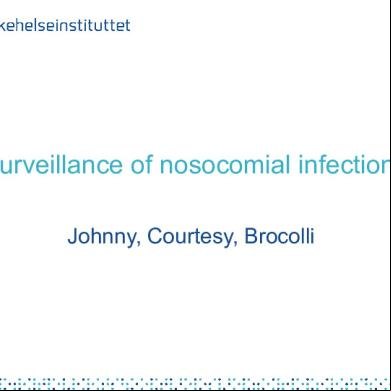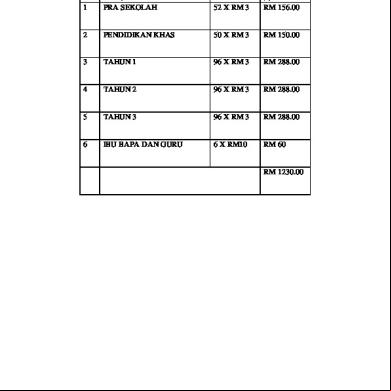Introduction To Nosocomial Infections 47266g
This document was ed by and they confirmed that they have the permission to share it. If you are author or own the copyright of this book, please report to us by using this report form. Report 3b7i
Overview 3e4r5l
& View Introduction To Nosocomial Infections as PDF for free.
More details w3441
- Words: 701
- Pages: 2
Introduction Hospital-acquired or nosocomial infections result in substantial morbidity, prolong hospital stay, increases in direct patient care costs and mortality. Although our understanding of the epidemiology of nosocomial infections has increased dramatically over the last two decades, the incidence of nosocomial infections continues to affect about 5% of hospitalized patients. There is evidence, however as reported by the Centers for Disease Control and Prevention (CDC) at the recent 4th Decennial International Conference on Nosocomial and Healthcare-associated Infections held at Atlanta in March that active hospital infection control programs lead to reduced infections and safer patient care. At the meeting, CDC reported a 10-year decline of over 30 percent in rates of hospital-acquired infections. Definition A nosocomial infection is defined as an infection that is not present or incubating when a patient is itted to a hospital or a healthcare facility. In determining if an infection is nosocomial or community-acquired, the incubation period of the specific infection must be taken into . Generally, for bacterial infection, a 48-72 hours after ission is used as a guide to discount the initial onset of the infection. It is important to note that nosocomial infections may be either endogenous or exogenous. Endogenous infections are caused by those organisms that are present as part of the patient’s own flora; exogenous infections on the other hand are those caused by organisms acquired by exposure to medical devices, hospital personnel, or the hospital environment. Incidence It is estimated that approximately 5% of patients in acute care tertiary hospitals develop nosocomial infection. A large proportion of these infections occur in patients with severe illnesses/trauma and those with poor underlying conditions in the intensive care units of hospitals. It is estimated that about a third of all nosocomial infections could have been prevented while the other two-thirds may be inevitable due the following reasons: • • •
Patient’s poor underlying condition/severe illness Impaired immunity Inherent risk of infection associated with sickness, medical and surgical intervention
Epidemiology Rates of nosocomial infection vary according to the type of hospital, type of patient and the level of patient risk. Generally, the rate of nosocomial infection is higher in surgical patients compared to those from the medical or obstetric and gynaecology services. Urinary tract infection, an infection often associated with the use of an indwelling urinary catheter or instrumentation of the urinary tract is by far the most frequent type of nosocomial infection reported. It s for between 30-40% of all nosocomial infections reported. Lower respiratory and surgical wound infections are the next two frequent nosocomial infections reported. Other less frequent nosocomial infections include bacteremia, intravenous site infection, gastrointestinal tract and skin infections.
Nosocomial infections can be caused by a wide variety of pathogens. These include Klebsiella sp. Escherichia coli, enterococci, Pseudomonas aeruginosa and Staphylococcus aureus. A significant proportion of these nosocomial pathogens has been reported to be multi-resistant to antibiotics. Methicillin-resistant Staphylococcus aureus or MRSA as it is commonly known, is one of the more problematic nosocomial pathogens faced by hospitals world-wide because of the high cost associated in treating these infections. Cost of nosocomial infection CDC has reported previously that nearly 2 million patients get an infection annually while being treated for other illness or injury, and nearly 88,000 die as a direct or indirect cause of these infections. The economic costs of these infections result largely from the extended length of stay in the hospital and the additional use of medical and therapeutic resources, including antibiotics to treat these infections. The cost varies according to the type and severity of these infections. In general, the number of extra days a patient has to spend in the hospital varies according to the type of infection he or she gets; an estimated 1 to 4 days for a urinary tract infection, 7 – 8 days for a surgical site infection, 7 – 21 days for a blood stream infection, and 7 – 30 days for pneumonia. The CDC has reported at the recent 4th Decennial International Conference on Nosocomial and Healthcare-associated Infections held at Atlanta that nearly US$5 billion are added to U.S. health costs every year as a result of infections that patients get while they are hospitalized for other health problems.
Patient’s poor underlying condition/severe illness Impaired immunity Inherent risk of infection associated with sickness, medical and surgical intervention
Epidemiology Rates of nosocomial infection vary according to the type of hospital, type of patient and the level of patient risk. Generally, the rate of nosocomial infection is higher in surgical patients compared to those from the medical or obstetric and gynaecology services. Urinary tract infection, an infection often associated with the use of an indwelling urinary catheter or instrumentation of the urinary tract is by far the most frequent type of nosocomial infection reported. It s for between 30-40% of all nosocomial infections reported. Lower respiratory and surgical wound infections are the next two frequent nosocomial infections reported. Other less frequent nosocomial infections include bacteremia, intravenous site infection, gastrointestinal tract and skin infections.
Nosocomial infections can be caused by a wide variety of pathogens. These include Klebsiella sp. Escherichia coli, enterococci, Pseudomonas aeruginosa and Staphylococcus aureus. A significant proportion of these nosocomial pathogens has been reported to be multi-resistant to antibiotics. Methicillin-resistant Staphylococcus aureus or MRSA as it is commonly known, is one of the more problematic nosocomial pathogens faced by hospitals world-wide because of the high cost associated in treating these infections. Cost of nosocomial infection CDC has reported previously that nearly 2 million patients get an infection annually while being treated for other illness or injury, and nearly 88,000 die as a direct or indirect cause of these infections. The economic costs of these infections result largely from the extended length of stay in the hospital and the additional use of medical and therapeutic resources, including antibiotics to treat these infections. The cost varies according to the type and severity of these infections. In general, the number of extra days a patient has to spend in the hospital varies according to the type of infection he or she gets; an estimated 1 to 4 days for a urinary tract infection, 7 – 8 days for a surgical site infection, 7 – 21 days for a blood stream infection, and 7 – 30 days for pneumonia. The CDC has reported at the recent 4th Decennial International Conference on Nosocomial and Healthcare-associated Infections held at Atlanta that nearly US$5 billion are added to U.S. health costs every year as a result of infections that patients get while they are hospitalized for other health problems.










